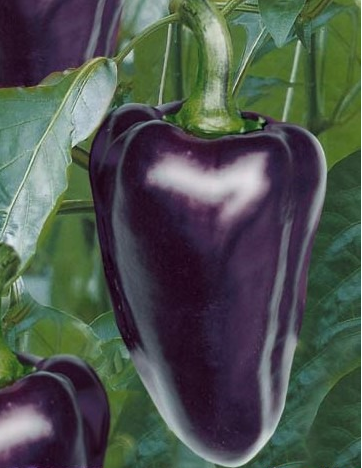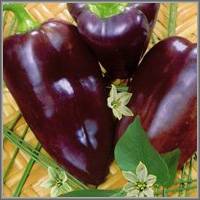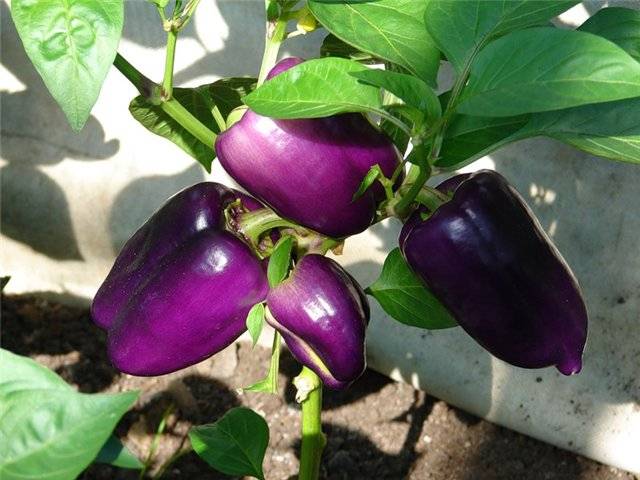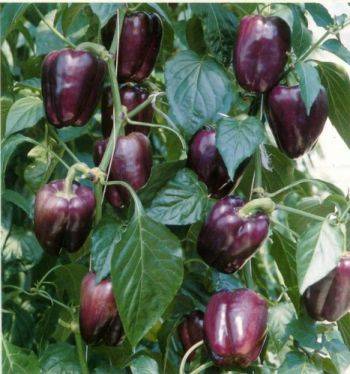Content
Pepper is a prominent representative of vegetable crops. It contains a lot of useful trace elements and vitamins. At the same time, the external qualities of the vegetable are amazing: the various shapes and colors of the fruits amaze a person's imagination. Green, yellow, orange, red peppers have long been grown by gardeners all over the world. But purple pepper can be considered an absolute exotic. It is unique not only for its color, but also for its agrotechnical features. Unfortunately, there are not too many purple varieties and the most famous of them are listed below.
Differences of purple pepper
The purple color of the vegetable is caused by an increased content of anthocyanin... This violet pigment is present in almost all cultures, but its presence is imperceptible at low concentrations. At the same time, a high concentration of anthocyanins gives the plant and its fruits not only a unique color, but also resistance to cold weather, which is especially important for such a heat-loving culture as pepper.
Anthocyanins allow the plant to absorb solar energy and convert it into heat energy, thereby increasing the plant's vitality. For example, many purple peppers can be grown in the northern regions of Russia.
For the human body, anthocyanins are also necessary, since they can have the following effects:
- destroy harmful bacteria. In the process of treating colds, it is recommended to increase the consumption of anthocyanins by 1.5 times;
- to strengthen the walls of blood vessels, including in the retina;
- lower intraocular pressure.
A person who regularly consumes foods rich in anthocyanins has strong immunity and keen eyesight. Purple peppers, along with other vitamins, contain a huge amount of this substance, so a unique vegetable grown in your garden can become not only tasty, but also extremely healthy food.
Purple pepper varieties
Among the purple peppers, there are varieties and hybrids. All of them differ in shade, shape, taste, yield. Choosing the best variety is difficult. In order not to be mistaken in the choice, a novice gardener should "listen" to the reviews and recommendations of experienced farmers. So, according to farmers, among the best purple peppers adapted to domestic latitudes are:
Arap
The Arap variety looks great both on the garden bed and on the table. Its color is very deep, deep purple. The surface is glossy, with a very thin skin. The walls of a vegetable of medium thickness (6.5 mm) are very juicy and sweet, they are especially tender.
The vegetable is characterized by a conical shape. The weight of each fruit is approximately 90-95 g. It is recommended to sow pepper seeds for seedlings in March, and after 110 days after that you can enjoy the first harvest. Both indoor and outdoor areas are excellent for cultivation of the variety. The plant painlessly tolerates temperatures above +120FROM.
The bush of the "Arap" variety is medium-sized. Its height reaches 75 cm. The plant needs regular loosening, watering and feeding. Its total yield in favorable conditions is 5.5 kg / m2.
Maxim F1
Pepper "Maxim F1" is a hybrid. It was obtained by the domestic breeding company Semko-Unix. Each bush of this culture forms simultaneously dark red and purple peppers. Vegetables of this variety are shaped like a cone. Their average length is in the range of 9-10 cm. The mass of one vegetable is from 60 to 80 g. The thickness of its walls is small (0.5-0.6 mm).For the harvest to ripen, at least 120 days must pass from the day of sowing the seed.
It is possible to grow purple peppers of the "Maxim F1" variety in a seedling way. In this case, sowing the seed should be done in March. You can cultivate peppers outdoors or in greenhouses, greenhouses. The bush of the plant is semi-spreading, medium-sized. Its height reaches 90 cm, which undoubtedly requires a garter. The recommended layout of peppers provides for the cultivation of 4-5 bushes per 1 m2 soil. The yield of the variety "Maxim F1" is 8 kg / m2.
Othello F1
The Othello F1 hybrid is another representative of the domestic selection. Its distinctive feature is the short ripening period of peppers - 110 days. Fruits of this variety at maturity are deep purple in color. Their shape is cone-like, the length is within 11 - 14 cm. The weight of each fruit is from 100 to 120 g. The pulp of the purple pepper "Othello F1" 7 mm thick is distinguished by sweetness and juiciness. You can evaluate the external qualities of the vegetable by looking at the photo below.
The variety can be grown in protected and open ground. The best time for sowing seeds for seedlings is March. If grown early, you can taste the crop as early as June. Plants of this variety are vigorous, so do not sow them densely. The recommended scheme for the variety is 3 plants per 1 m2 soil. Mandatory operations during cultivation are garter, watering, loosening, top dressing. In gratitude for proper care, the pepper bears fruit in a volume of 9 kg / m2.
Lilac Mist F1
This hybrid is light purple in color. Some fruits on the bush at maturity are red in color. The shape of the peppers is like a truncated pyramid. Each vegetable weighs within 100 g. The pulp of the fruit is juicy, its thickness is average. The variety is disease-resistant, perfectly tolerates cold snaps, and is recommended for cultivation in the northern regions of Russia.
From the day of sowing the seed, until the ripening of the fruits of this variety, it is necessary to wait 120 days. Open ground and hotbeds, greenhouses are suitable for growing. The plant bush has an average height, so it is planted at the rate of 3 bushes per 1 m2... Each bush of this variety bears peppers in a volume of up to 2 kg, which provides a total yield of up to 6 kg / m2.
Amethyst
"Amethyst" is recognized as one of the best cold-resistant varieties. It has an amazing, record-breaking crop yield, up to 12 kg / m2... At the same time, the fruit ripening period is short - 110 days. One plant forms red and purple vegetables, weighing up to 160 grams. The walls of the pepper are fleshy, juicy, especially sweet. The variety is characterized by a unique, pronounced aroma.
It is possible to grow the variety "Amethyst" in greenhouses or on open ground. The plant is compact, of medium height (up to 60 cm). This allows you to plant 4 bushes per 1 m2 soil.
Oh yeah
An excellent variety of sweet peppers. Its fruits are colored with shades ranging from light purple to deep purple. Their shape is cuboid, the mass varies from 100 to 150 g. The pulp is juicy, aromatic, sweet. Peppers are used for making fresh salads, preserving and making paprika as an additional component.
It takes at least 115 days to ripen peppers of the "Oda" variety. The bushes of the plant are compact, undersized (up to 50 cm), do not need a garter. The variety is resistant to cold weather and diseases, it is recommended for growing in areas with difficult climatic conditions. The total yield of pepper is 6 kg / m2.
Star of the East (purple)
Pepper "Star of the East" is familiar to many gardeners.It is presented in a number of varieties, with fruits of various colors. So, under this name you can find vegetables of red, yellow, orange, golden, chocolate, white and, of course, purple. Purple "Star of the East" surprises with its beauty and deep dark purple color. The vegetable is recommended for cultivation in Russia, and the poor climate of some regions is not an obstacle to its cultivation.
The variety is early ripe, the fruits of the pepper ripen in 100-110 days. Their shape is cuboid. Each vegetable weighs about 200 g. Its walls are thick and fleshy.
Sowing seeds of this variety for seedlings can be carried out in March-April, depending on the climatic features of the area. The plant develops favorably at temperatures above +100C. The total crop yield is 7 kg / m2.
Pepper belongs not only to the category of thermophilic, but also quite whimsical crops. Therefore, in addition to choosing a variety, attention should be paid to the rules of cultivation. The features of growing a vegetable are described in detail in the video:
findings
Purple bell peppers, due to their agrotechnical characteristics and adaptability to cold weather, are excellent for the middle and northwestern part of Russia. Each variety of this unusual vegetable undoubtedly brings with it aesthetic and gustatory pleasure, as well as irreplaceable health benefits. Having picked up a good variety and observing all the rules of cultivation, every farmer will be able to grow a wonderful harvest with his own hands.






.jpg)








